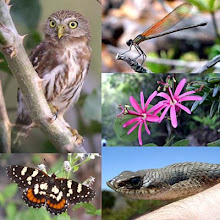September
13, 2015
After an
early departure from Santa Cruz, we drove until we came to a side road I had
staked out for a picnic breakfast and some fun early morning birding. On this
tour we have a bus driver, Carlos, and his sister Benita, a cook we are
borrowing from her regular job as cook and manager at Refugio Los Volcanes. A
hot cooked breakfast every day is quite a luxury.
We heard
Red-legged Seriemas again here, but couldn’t get close enough to see.
White-tipped Doves were everywhere and several species of parrots were leaving
their roosts to go feed somewhere for the day. The fanciest one, and one that
was cooperative enough to perch for spotting scope views was this Yellow-collared
Macaw.
Another sign
of a wet winter was this bignoniaceous vine in full bloom.
As we
continued south on the main highway we stopped for our first Green-cheeked
Parakeets and this Toco Toucan perched next to the road.
Another
birding stop along the way was Rio Seco, a well-named, broad, sandy river bed
that must flow only during a short time after heavy rains in the foothills to
the west.
I don’t
usually encounter too many butterflies at this season; as with the Pantanal,
it’s been dry and sometimes cold with the passage of cold fronts, and their
populations are at their annual low. I’ve been here in February and March,
when butterflies are everywhere.
This metalmark therefore stood out. I think it is Emesis diogenia.
This skipper
is the widespread Polythrix caunus,
Four-spotted Longtail.
We had made
good time, so it was nice to get to spend a while checking out the marshy edges
of Laguna Tatarenda. Here were these Black-necked Stilts, formerly split as
White-backed Stilt. They not only look obviously different, but they have much
lower and more nasal calls than our northern birds. I’d be surprised if there
really were much intergradation, and I suspect a re-split is in order.
I had called
out a group of White-faced Ibis, which I photographed, then we concentrated on
looking at other birds. I later looked at my photos and realized that these
looked like Puna Ibis, a bird I wouldn’t have expected at this low elevation.
But these are probably wintering birds from much farther south. Note the
thicker and shorter neck and thicker, redder bill.
This small puddle
party of sulphurs contains five species – most on the right are Phoebis argante, Apricot Sulphur; second
in from right is a Phoebis sennae, Cloudless
Sulphur; the white one front-center is Aphrissa
statira, Statira Sulphur; the giant greenish one second from left is Anteos clorinde, White Angled-Sulphur;
and the one on the far left and behind the Anteos is Phoebis neocypris, Tailed Sulphur.
We birded
another road not far from here that went a bit into the foothills, covered in a
semihumid forest that is difficult to characterize. In it we found Two-banded
Warblers and White-bellied Hummingbird to be common, while some of us glimpsed
a Saffron-billed Sparrow and a White-backed Fire-eye.
This huge,
super dense nest of silk webbing, seemingly anchoring the tree to the ground,
appears to belong to a tent caterpillar, presumably a moth in the family
Lasiocampidae.
We arrived
in the late afternoon at our hotel for the next three nights, right on the
outskirts of Camiri.

















No comments:
Post a Comment